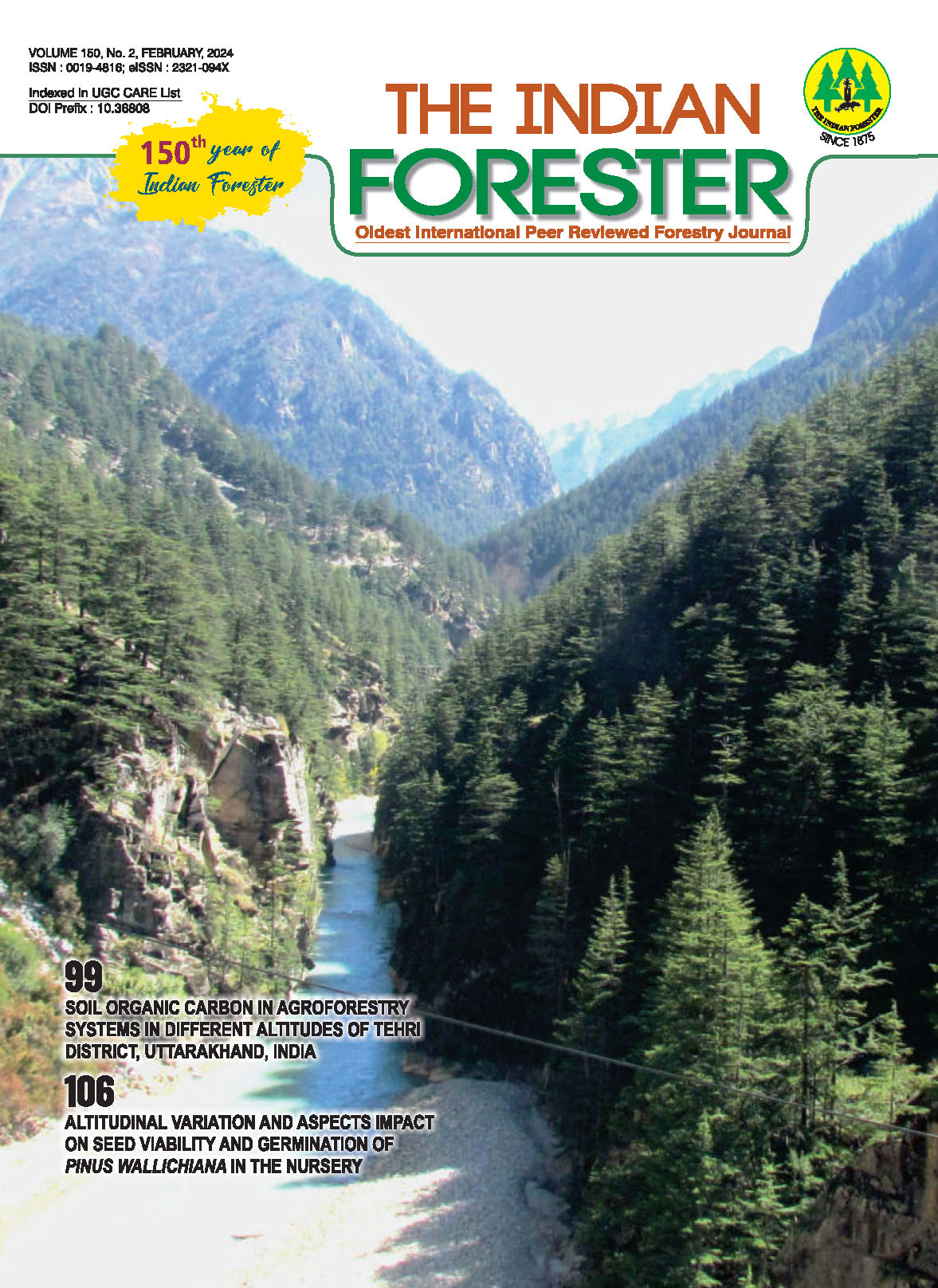Soil Organic Carbon in Agroforestry Systems in Different Altitudes of Tehri District, Uttarakhand, India
DOI:
https://doi.org/10.36808/if/2024/v150i2/169654Keywords:
Agroforestry, Altitudes, Bulk Density, Carbon Stock.Abstract
Agroforestry system increases organic carbon accumulation in soil by providing continuous supply of organic matter over time. Soil organic carbon is a key component of terrestrial ecosystem that helps in enhanced sequestration of atmospheric CO2 in the soil. This study was carried out during the year 2017 in Tehri Garhwal district of Uttarakhand. Three agroforestry systems selected were Agrihorticulture (AH), Agrisilviculture (AS) and Agrihortisilviculture (AHS) in three altitude viz., Lower altitude (286-1200 m), Middle altitude (1200-2000 m), and Upper altitude (2000-2800 m). Ten sample plots (100 m2 ) were randomly laid out in each agroforestry system on each altitude of each block. Soil organic carbon was determined at three different depth 0-10, 10-20 and 20-30 cm. Maximum bulk density (1.38 g cm-3 ) was recorded in the agrisilviculture system and minimum in agrihorticulture system (1.29 g cm-3 ). Maximum soil organic carbon (2.74%) was found in the agrihorticulture system and minimum in agrisilviculture system (2.48%). The soil organic carbon also increased significantly with the ascending altitudes. It was concluded that upper altitude (2000-2800 m) and agrihorticulture system had accumulated greater soil organic carbon pool and suggested that, if need be, conversion of agriculture field should be into agrihorticulture system in Northwestern Himalayas for better soil carbon sequestration.References
Beer J., Bonnemann A., Chavez W., Fassbender H.W., Imbach A.C. and Martel I. (1990). Modelling Agroforestry systems of Cocoa (Theobroma cocoa) with laurel (Cordia alliadora) and poro (Erythrina poeppigiana) in Costa Rica. Agroforestry System, 12: 229-249.
Bhardwaj D.R., Sanneh A.A., Rajput B.S and Kumar S. (2013). Status of soil organic carbon stocks under different land use systems in wet temperate North Western Himalaya. Journal of Tree Science, 32(1 & 2): 14-22.
Chisanga K. (2012). Carbon storage potential and bioeconomic appraisal of different land use systems in dry temperate North Western Himalaya. M.Sc thesis, Dr. Y.S. Parmar university of Horticulture and Forestry, Nauni, Solan (H.P), India.
Dadhwal V.K. and Nayak S.R.I. (1993). A preliminary estimate of biogeochemical cycle of carbon for India. Current Science, 59: 9–13.
Dadhwal K.S., Narain P. and Dhyani S.K. (1988). Agroforestry systems in the Garhwal Himalayas of India. Agroforestry System, 7: 213–225.
Davidson E.A., Trumbore S.E. and Amudson R. (2000). Soil warming and organic carbon content. Nature, 408: 789-790.
FSI (2015). State of Forest Report. Forest survey of India Ministry of Environment, Forest and Climate change, Government of India, Dehradun, Uttarakhand,
Goswami S., Verma K.S. and Kaushal R. (2014). Biomass and carbon sequestration in different agroforestry systems of a Western Himalayan watershed. Biological Agriculture & Horticulture, 30: 88-96.
Gupta R.K. and Rao D.L.N. (1994). Potential of wastelands for sequestering carbon by reforestation. Current Science, 66: 378–380.
Islam N., Hossen S. and Baten A. (2016). Soil Carbon and Nitrogen Dynamics in Agricultural Soils of Mymensingh, Bangladesh. International Journal of Agricultural and Biosystems Engineering, 1: 1-8.
Kumar Munesh, Anemsh K., Mehraj A.S. and Raj A.J. (2012). Structure and carbon stock potential in traditional agro forestry system of Garhwal Himalaya. Journal of Agriculture & Technology, 8(7): 2187-2200.
Kumar B.M., George S.J. and Suresh T.K. (2001). Fodder grass productivity and soil fertility changes under four grass + tree associations in Kerala, India. Agroforestry Systems, 52: 91-106.
Mac Dicken (1997). A guide to monitoring carbon storage in forestry and agroforestry projects. Winrock International Institute for agricultural development, Forest carbon monitoring programme, pp 1-87.
Parmar B., Vishwakarma A., Padbhushan R., Kumar A., Kumar R., Kumari R., Kumar Yadav B., Giri S.P., Kaviraj M. and Kumar U. (2022). Hedge and Alder-Based Agroforestry Systems: Potential Interventions to Carbon Sequestration and Better Crop Productivity in Indian Sub-Himalayas. Frontier in Environmental Science. Doi: 10.3389/fenvs.2022.858948
Pearson T.R., Brown S.L. and Birdsey R.A. (2007). Measurement guidelines for the sequestration of forest carbon, U.S. Northern Research Station, United States Department of Agriculture, pp 1-47.
Post W.M. and Kwon K.C. (2000). Soil Carbon Sequestration and Land-Use Change Processes and Potential. Global Change Biology, 6: 317-327.
Post W.M., Pengh T.H., Emanuel W., King A.W and Dale V.H. (1990). The global carbon cycle. American Science, 78: 310-326.
Rajput B.S. (2010). Bioeconomics appraisal and carbon sequestration potential of different land use systems in Temperate North-Western Himalaya. Ph.D thesis, College of Forestry, Dr. YS Parmar university of Horticulture & Forestry, Nauni Solan (H.P), India.
Rao M.R., Nair P.K.R and Ong C.K. (1998). Biophysical interactions in tropical agroforestry. Agroforestry Systems, 38: 3-50.
Sathaye J.A. and Ravindranath N.H. (1998). Climate Change Mitigation In The Energy And Forestry Sectors Of Developing Countries. Annual Review of Energy and the Environment, 23: 327-437.
Singh Karan, Bhandari A.R and Tomar K.P. (1991). Morphology, genesis and classification of some soils of North Western Himalayas. Journal of Indian Society of Soil Science, 39: 139-146.
Singh J.S and Singh S.P. (1992). Forests of Himalaya: Structure, Functioning and Impact of Man. Gyanodaya Prakashan, Nainital, Uttarakhand, India, 1992, 294pp.
Tian H., Melillo J.M., Kicklighter and D.W. (2002). Regional carbon dynamics in monsoon Asia and implications for the global carbon cycle,. Global & Planetary Change, 37: 201 217.
Toky O.P., Kumar P and Khosla P.K. (1989). Structure and function of traditional agroforestry systems in Western Himalaya. I. Biomass and productivity. Agroforestry System, 9(1): 47-70.
Verma Archana., Tewari J.C., Kaushal R and Suresh N.V. (2016). Agroforestry for carbon sequestration in North Western Himalaya. In: Agroforestry Research and Development, (ed. Dagar JC, Tewari JC), 308-325.
VSN International (2017). General statistics for windows 19th edition.VSN International, Hemel Homstead, UK. Genstat.co.uk. 2017.
Walkley A.J. and Black I. (1934). Estimation of soil organic carbon by chromic acid titration method. Soil Science, 37: 29–38.
Zegeye M.W. (1999). Tree crop interaction studies in agri-horti-silviculture system. M.Sc Thesis, Dr. Y.S Parmar University of Horticulture and Forestry, Nauni, Solan (HP) India.
Downloads
Downloads
Published
How to Cite
Issue
Section
License
Unless otherwise stated, copyright or similar rights in all materials presented on the site, including graphical images, are owned by Indian Forester.





